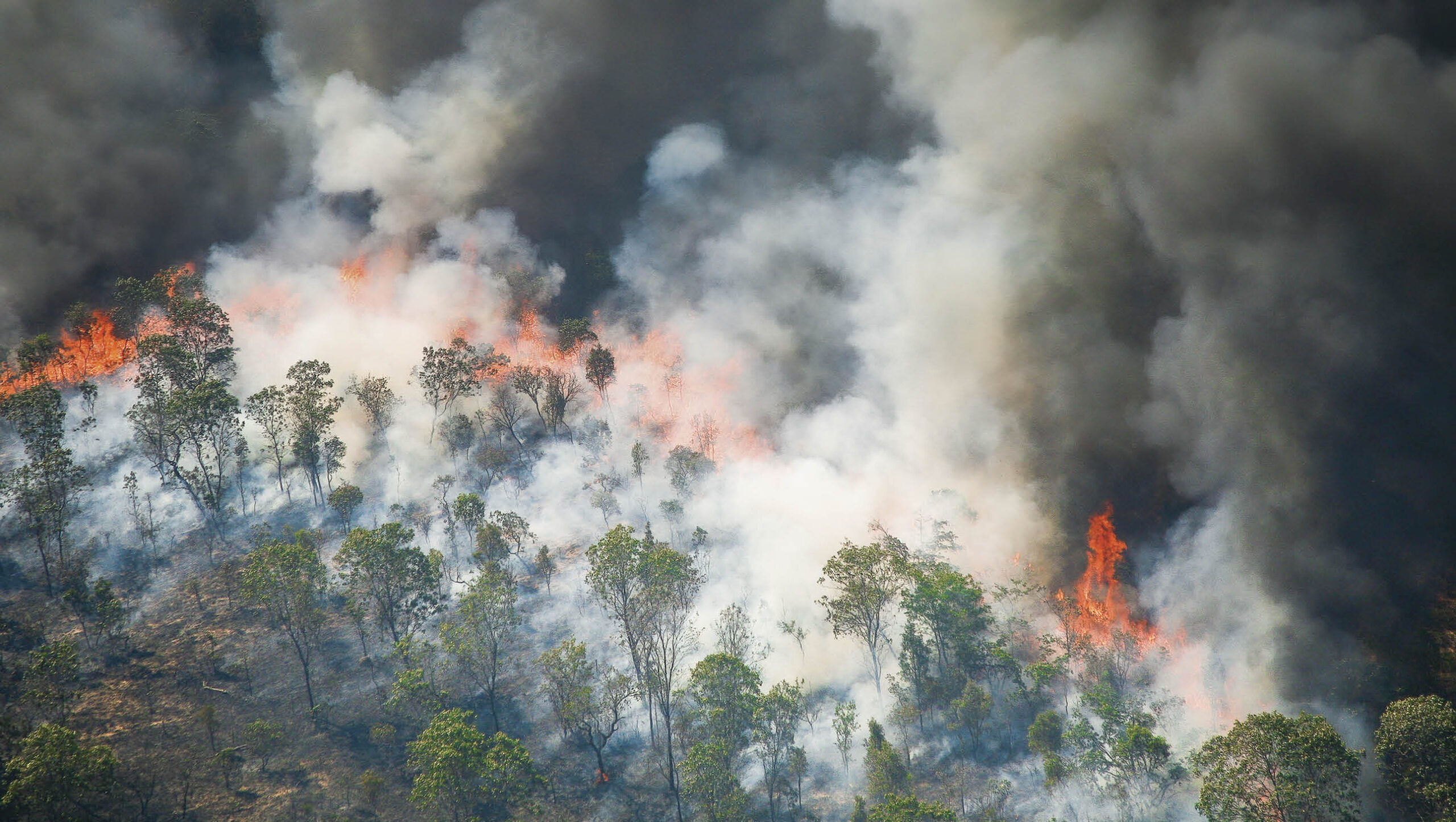Earth calling SOS
2025-03-27T11:27:02+11:00
It is time for us all to harness our courage and the people power in our communities as we never have before to answer our planet's call for help.
Earth as a single system is complex, in that it can exist in a well-defined state, but if it is pushed hard enough with heat it will flip into another state, without stopping in between.
A European study has concluded that temperature rises over 2°C strongly accelerate the risk of reaching tipping points, which could lead to rapid and irreversible collapse. It’s a world that all current ecosystems and organised civilisation won’t be in.
Earth’s four pillars
Scientists have identified four main pillars of stability for life on Earth: the West Antarctic Ice Sheet, Greenland Ice Sheet, Amazon Rainforest and Atlantic Meridional Overturning Circulation (AMOC). AMOC is an ocean conveyor belt between the North and South poles that disperses equatorial heat and recirculates cold polar waters. If one of the four pillars falls, the others could tumble like dominoes due to the interconnected nature of each system.
“The future of humanity hangs in the balance,” said a team led by American scientists in a 2024 state of the climate report in the journal BioScience. Twenty-five Earth vital signs are at record risk levels.
We are already seeing 50°C heatwaves in India, super typhoons in South-East Asia, torrential flooding across Europe and Australia and increasing bushfires in the Amazon Rainforest and the Boreal Forest. Just ask the global insurance industry; since 2019 it has paid out about US$525bn.
The UN says 2.4bn workers – 71 per cent of the world’s workforce – are now exposed to excessive heat during their work.
Those in less wealthy countries will suffer more, without the resources to repair infrastructure and support affected citizens.
Forest fortresses collapsing
In 2023, it was so hot that trees and land absorbed almost no carbon, whilst CO2, methane and nitrous oxide concentrations surged to record levels. South America is in the grips of a fiery continental-wide drought. In September 2024, a main tributary of the Amazon River was at its lowest level ever recorded. The jungle and wetlands are profusely bleeding CO2 and methane as the Amazon Rainforest races towards collapse.
Meanwhile, Canada’s forests are haemorrhaging an extraordinary amount of CO2. Also, Finland’s forests are tinderbox dry – between 2017 and 2023, the amount of standing dead trees in south-east Finland, leaking CO2, increased ninefold.
While Mother Earth is on bended knees, since the Paris Agreement major banks have funnelled more than US$395bn to industry sectors linked with deforestation. Rainforests have no rights.
Trees, especially the tall ones, are indispensable carbon storehouses, and providers of food, shelter and shade for forest species. In times of drought, big trees are able to move water from trunk reserves to the circulatory system, xylem, and share it during the night-time with surrounding smaller trees. The taller they grow, the more water tissue and more food reserves for deeper root growth to draw deep water and stockpile carbon.
Trees are life. Alas, one in every three tree species is threatened with extinction, according to the International Union for Conservation of Nature. “There’s no excuse not to act”, said Jean-Christophe Vié, director of Foundation Franklinia, a non-profit organisation that funded the global tree assessment.
Forests are the world’s last fortresses between a liveable and hothouse Earth. They’re burning up.
Since 2001, global bushfire carbon dioxide emissions have risen 60 per cent. Emissions from the northern Boreal Forest has almost tripled. This, too, is boosting global heating.
Further north, the thawing Arctic Circle’s peat, deep carbon deposits, are experiencing ground fires and discharging heat.
We can no longer wish and hope; every citizen needs to be supporting forest protection, defending the trees in whatever way they are able.
Flying rivers under threat
Rainforests are Earth’s primary air conditioners, and contribute 80 to 90 per cent of terrestrial atmospheric water. They are colossal climate drivers and inimitable carbon caches.
Put another way, forests are temperature-sensitive, self-sustaining, rainmaking systems. For every wooden tree tonne, one thousand tonnes of water are filtered and released into the sky.
Drs Victor Gorshkov and Anastassia Makarieva theorise that not only do forests recycle huge amounts of moisture into the air, but also, they whip up winds that pump that water around the world. Forests, they say, make flying rivers.
Those rivers in the sky stretch from all major forests of the world. Along with the Amazon and its flying rivers others carry moisture to North America through the forests of South-East Asia, and from the Congo rainforest to both the Sahel and Ethiopia. The longest of the flying rivers glides west to east 6400km across the Eurasian landmass. The bulk of China’s rain comes from the Scandinavian and Siberian forests – a trek involving several legs and taking six months or longer.
Flying rivers seasonally irrigate the world’s bread baskets, vital moisture for billions of nightly meals. One valid concern about increasing worldwide forest fires is that any disruption to the flying rivers could affect global food security.
For example, the Amazon Rainforest is one of the planet’s largest carbon repositories. The hotter it gets, the drier it becomes. The more the Amazon burns, the more stored carbon is unlocked and thrust into the atmosphere, fanning more global heating. It’s a deadly self-reinforcing loop that’s accelerating towards the Amazon flying rivers running dry.
Junk the GDP
We require a Mother Earth Living Economy with a Contentment Index that measures equality, housing, health and nutrition; the availability of freshwater, clean air, vibrant soils and a smorgasbord of insects; the well-being of Indigenous Peoples and women, along with a hale and hardy Earth System. These are imperative metrics of progress so that young people can live full lives.
My late friend and colleague, ANU’s eminent Earth System scientist, Will Steffen, told me: “The way we think, our value system and social organisation must change – pronto!”
Fossil fuel subsidies impeding progress
Sunshine, wind, lithium, brainpower, a capable workforce and green financiers can give us all the power we need, yet amidst a climate emergency, our governments back ruinous hydrocarbon subsidies.
While Australians pay steep prices at the petrol bowser and suffer the costs of high insurance from floods, fires and intense storms, an ATO report revealed that some multinational fossil fuel companies profited billions in 2022 but paid no Australian corporate taxes.
In their defense, the Australian Petroleum Production and Exploration Association (APPEA) former acting CEO, Damian Dwyer said: “These criticisms misrepresent our contribution, excludes direct payments like royalties and rents, and doesn’t reflect the way our tax system works.”
Economists Ross Garnaut and Rod Sims have proposed a $100 billion-a-year fossil fuel tax on Australia’s fossil fuel production and imports, which would help Australia transition to a carbon-free energy source while reducing global emissions and lowering the cost of living.
This begs a more urgent question: why in 2023–24 did fossil fuel conglomerates receive subsidies of $14.5bn?
The main subsidy currently in place is the Fuel Tax Credit Scheme, which subsidises the consumption of fossil fuels for vehicles over 4.5 tonnes.
The Australian government also subsidises aviation fuel, offers concessions on the Petroleum Resource Rent Tax, and provides infrastructure for fossil fuel companies.
The Australia Institute’s Polly Hemming says: “It’s perverse that Australian taxpayers are effectively paying to make climate change worse.”
And it is getting worse. Southerners may not be aware, but the Northern Territory 2023 spring bushfires burned 33 million hectares, an area larger than the Black Summer.
Since May 2022, the Albanese government has given the go-ahead for 11 new coal mines or expansions. In 2023, 116 new fossil fuel projects were on the federal government’s major projects list. In defiance of climate science this ill-conceived commitment to unearth and sell Australia’s carbon fuels, along with combusting coal from hundreds of new and proposed world mines, will broil Earth.
Meanwhile, regardless of the Paris Agreement and intensifying heatwaves, firestorms, floods, droughts and crop failures, 60 banks have fed $6.9tn into new fossil fuel schemes. The world’s leaders, too, have facilitated more fossil fuel extractions, with a record US$7tn of subsidies in 2022. Consequently, Big Oil posted obscene 2023 profits of $173bn.
The only remedy is for citizens to rise up and demand rapid decarbonisation. New fossil fuel exploits and subsidies need to be scrapped. By investing $7tn annually into battery storage, heat pumps and electrifying everything, the world could be fossil fuel-free by 2035, according to Professor Mark Jacobson, of Stanford University.
Australia has a burgeoning future in the exporting renewables sector. The Australian Conservation Foundation’s Sunshot Report estimates that Australia could create 395,000 new well-paying jobs while adding $89bn a year to the economy through zero-combustion energy exports.
More reading
- Project Drawdown and Drawdown the book, edited by Paul Hawken: drawdown.org
- The Climate Book, created by Greta Thunberg, Penguin
- 2040: A handbook for the regeneration (based on the documentary 2040), Damon Gameau, Pan Macmillan
- Hothouse Earth, Bill McGuire, Brotherhood Books
- No Miracles Needed, Mark Z. Jacobson, Cambridge University Press
References and research links
- academic.oup.com/bioscience/advance-article/doi/10.1093/biosci/biae087/7808595
- amp.theguardian.com/environment/2024/oct/08/earths-vital-signs-show-humanitys-future-in-balance-say-climate-experts
- theguardian.com/environment/2022/jul/21/revealed-oil-sectors-staggering-profits-last-50-years
- thebulletin.org/2024/04/world-set-to-quadruple-oil-and-gas-production-by-2030-led-by-new-us-projects/
- phys.org/news/2024-02-economists-billion-year-fossil-fuel.html
- acf.org.au/sunshot-summary-report
- worldwildlife.org/press-releases/catastrophic-73-decline-in-the-average-size-of-global-wildlife-populations-in-just-50-years-reveals-a-system-in-peril
- un.org/en/climatechange/extreme-heat
- arxiv.org/pdf/2407.12447
- wmo.int/media/news/greenhouse-gas-concentrations-surge-again-new-record-2023
Dr Reese Halter is a distinguished Earth System scientist, broadcaster and activist-protester.






